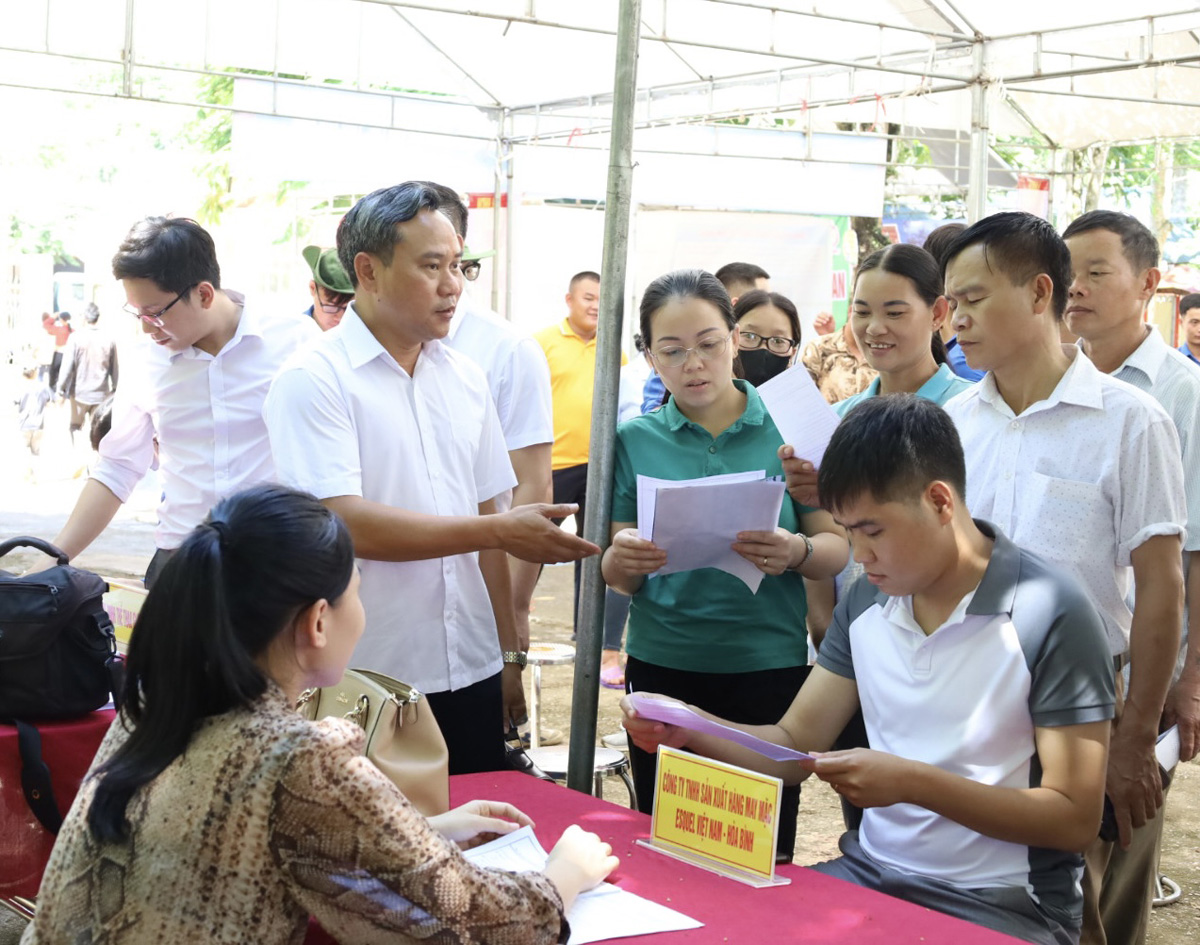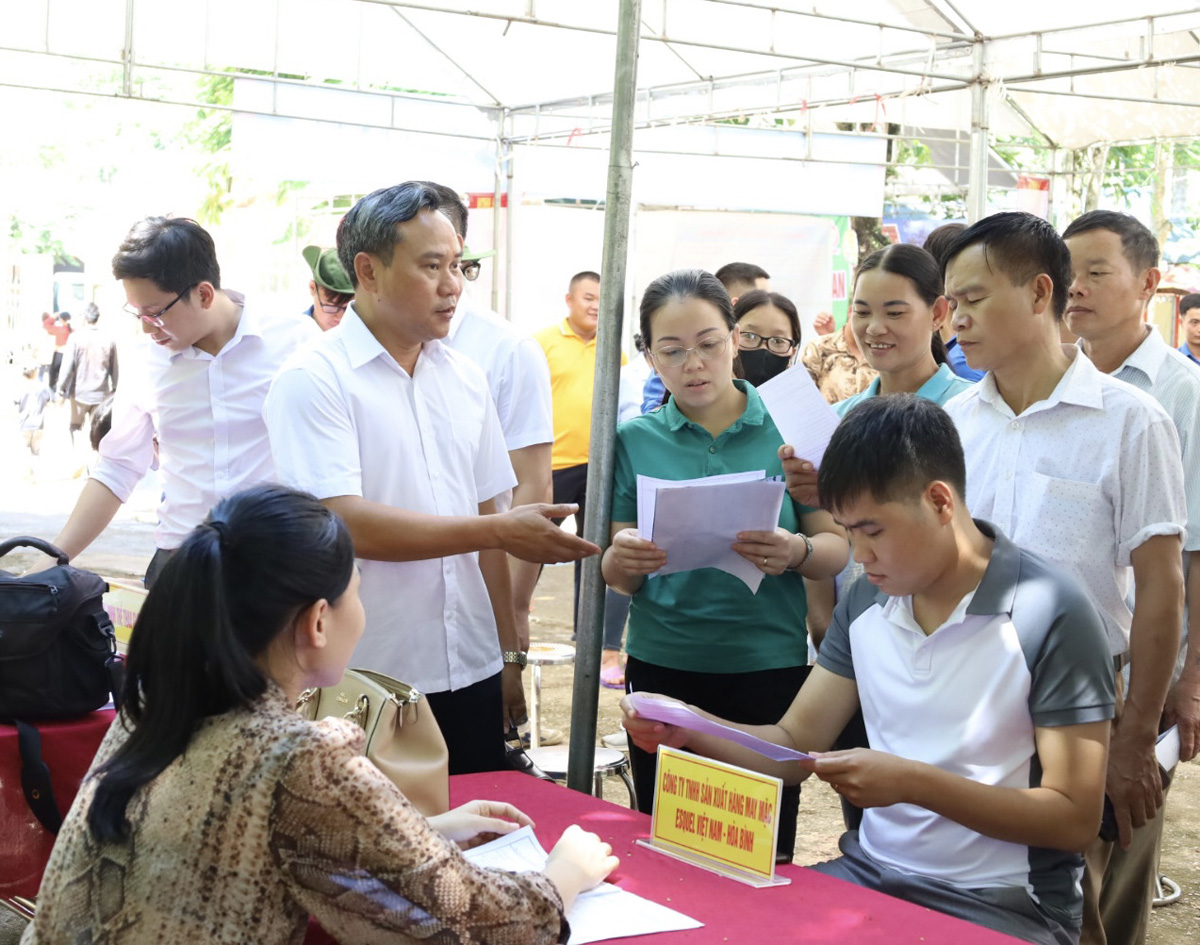
(HBĐT) - Hoa Binh authorities have been implementing solutions to develop the labour
market, aiming to establish a solid foundation for the comprehensive development
of labour market elements, thus promoting socio-economic development and
labour restructuring in order to ensure the connection of the local labour market
with those in other localities nationwide.
Workers in Phu Vinh commune (Tan Lac district) are seeking information about the labour market and job opportunities through the provincial job service centre and recruiting businesses.
Last year, over 19,000 local labourers were provided with employment, while 720 individuals were sent to work abroad. Approximately 17,700 workers were recruited for vocational training. The rate of trained workers reached 59.23%.
In the first half of this year, 7,641 labourers were provided with jobs, equivalent to 47.7% of the target set for the year. As many as 385 workers were recruited to work abroad under contracts, reaching 128% of the year plan. A total of 3,143 individuals received unemployment insurance payments, amounting to nearly 46.2 billion VND (nearly 1.95 million USD). The provincial job service centre is collaborating with localities to organise job fairs, aiming to provide information on the labour market to various groups within the working age, including students of high schools, colleges and vocational schools.
Hoa Binh Technical and Technology College, Hoa Binh Economic & Technical College, and the vocational education institutions across districts and Hoa Binh city have intensified their efforts to improve the quality of training, and implementing projects under the national target programme for vocational education, and reviewing the demand for basic-level vocational training, and providing regular training for labourers in ethnic minority and mountainous regions.
Bui Manh Cuong, Deputy Director of the provincial Department of Labour, Invalids, and Social Affairs, stated that to achieve and surpass the targets of employment generation, better labour qualifications and quality, reduce the unemployment rate in 2023, and meet the goals of labour market development in the coming years, besides implementing comprehensive policies and laws, local authorities has implemented programmes and initiatives related to job creation and vocational training, and provided labour market information for specific groups, including people with disabilities, ethnic minority and rural workers. Various training and skill development programmes, career initiatives for new graduate students, and campaigns to popularise policies on labour, employment, labour export, and social insurance have been organised, Cuong said.
According to data from the Hoa Binh Provincial Party Committee, the industrial production index for the first six months of 2025 is estimated to have increased by 20% compared to the same period last year. This marks the highest year-on-year growth rate for this period since 2020.
In the first six months of 2025, Hoa Binh province’s export turnover was estimated at 1.145 billion USD, marking an 18.11% increase compared to the same period in 2024. Import turnover was estimated at $ 804 million, a 17.15% increase, which helped the province maintain a positive trade balance.
The lives of the ethnic minority farmers in Tan Lac district have gradually improved thanks to the new directions in agricultural production. This is a testament to the collective strength fostered through the professional associations and groups implemented by various levels of the district’s Farmers’ Union.
With the motto the "product quality comes first,” after nearly one year of establishment and operation, Muong village’s Clean Food Agricultural and Commercial Cooperative, located in Cau Hamlet, Hung Son Commune (Kim Boi district), has launched reputable, high-quality agricultural products to the market that are well-received by consumers. The products such as Muong village’s pork sausage, salt-cured chicken, and salt-cured pork hocks have gradually carved out a place in the market and they are on the path to obtaining the OCOP certification.
In the past, the phrase "bumper harvest, rock-bottom prices" was a familiar refrain for Vietnamese farmers engaged in fragmented, small-scale agriculture. But today, a new spirit is emerging across rural areas of Hoa Binh province - one of collaboration, organisation, and collective economic models that provide a stable foundation for production.
Maintaining growing area codes and packing facility codes in accordance with regulations is a mandatory requirement for agricultural products to be eligible for export. Recently, the Department of Agriculture and Environment of Hoa Binh province has intensified technical supervision of designated farming areas and packing facilities to safeguard the "green passport" that enables its products to access international markets.



